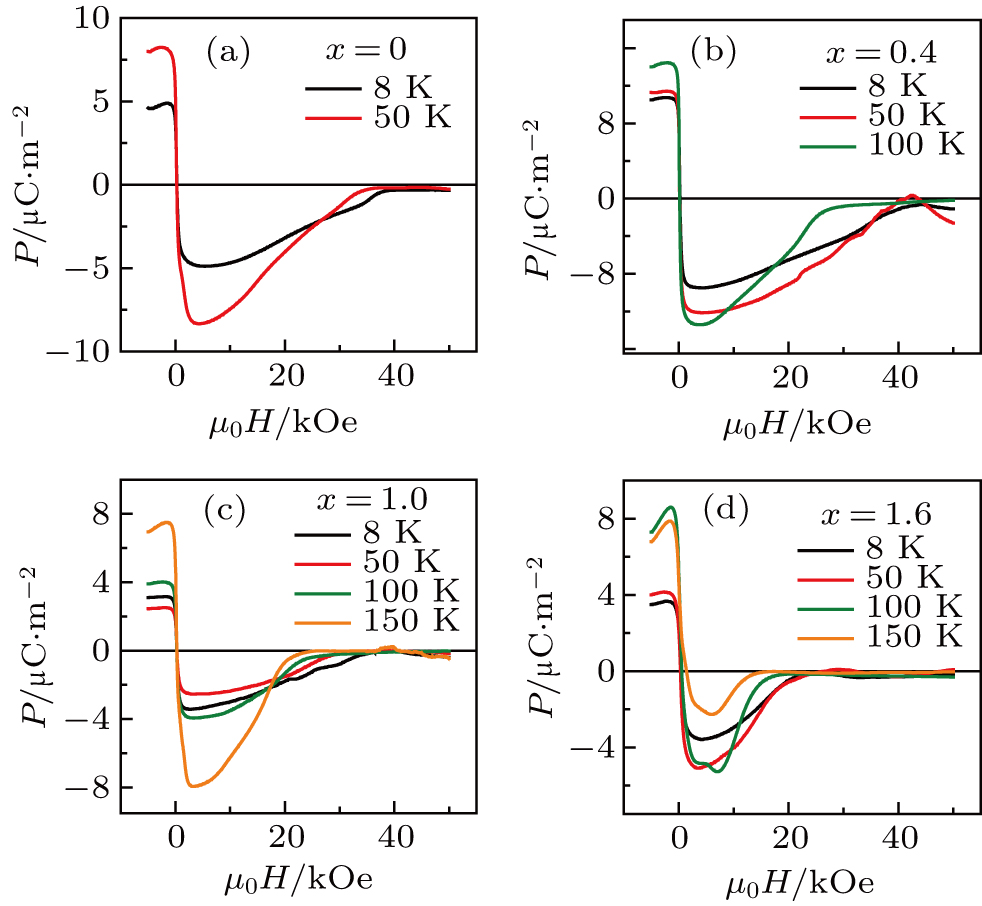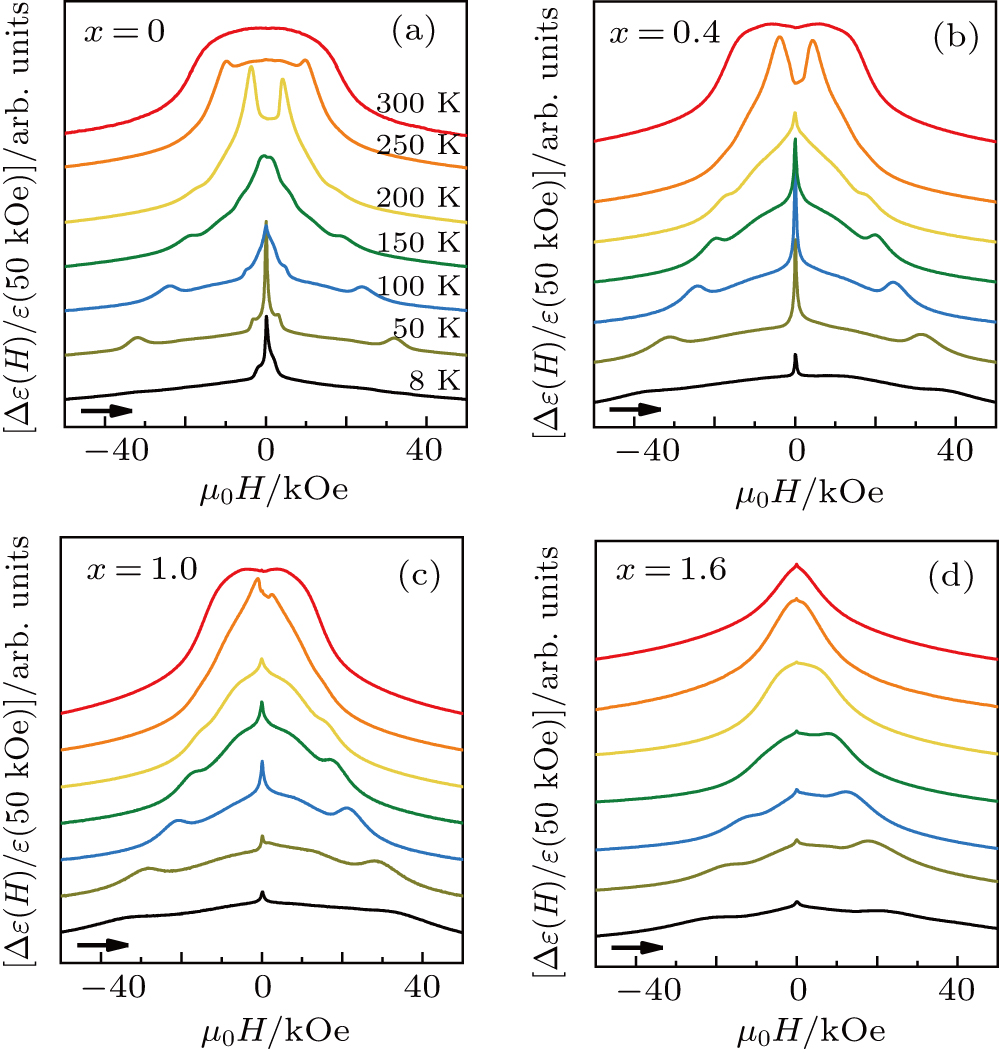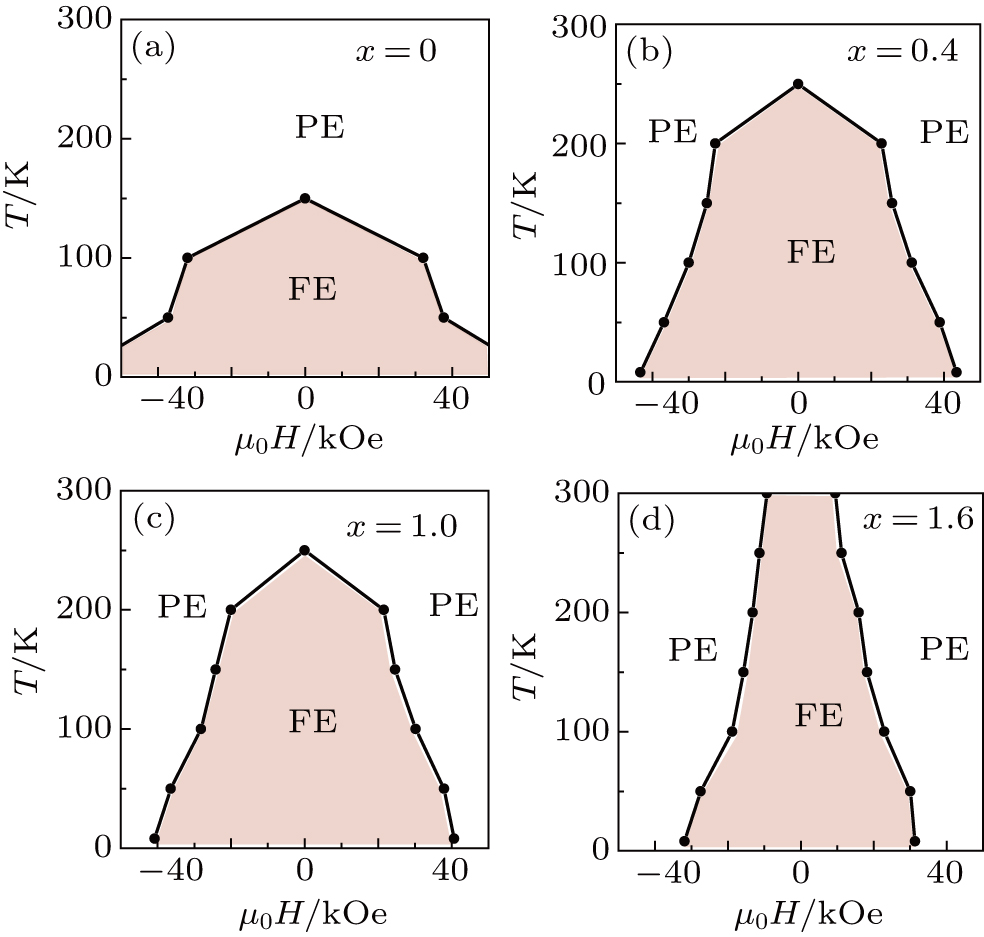† Corresponding author. E-mail:
Project supported by the National Natural Science Foundation of China (Grant No. 51725104) and Beijing Natural Science Foundation, China (Grant No. Z180009).
Y-type hexaferrites with tunable conical magnetic structures are promising single-phase multiferroics that exhibit large magnetoelectric effects. We have investigated the influence of Co substitution on the magnetoelectric properties in the Y-type hexaferrites Ba0.3Sr1.7CoxMg2−xFe12O22 (x = 0.0, 0.4, 1.0, 1.6). The spin-induced electric polarization can be reversed by applying a low magnetic field for all the samples. The magnetoelectric phase diagrams of Ba0.3Sr1.7CoxMg2−xFe12O22 are obtained based on the measurements of magnetic field dependence of dielectric constant at selected temperatures. It is found that the substitution of Co ions can preserve the ferroelectric phase up to a higher temperature, and thus is beneficial for achieving single-phase multiferroics at room temperature.
The magnetoelectric (ME) multiferroic materials in which magnetism and ferroelectricity coexist have drawn a lot of attention for more than a decade.[1–6] The coexistence of magnetic and ferroelectric orders could enable mutual control of magnetization by an electric field and electric polarization by a magnetic field. Therefore, the ME multiferroics have a great potential for developing new functional devices.[7–9] Although a large number of ME multiferroics have been discovered and investigated,[10–14] single-phase multiferroics with large ME effects are still very limited. Y-type hexaferrites are considered to be one of the most promising single-phase multiferroics due to the intrinsically coupled magnetic and ferroelectric orders at low fields.[15–18] For instance, Zhai et al. obtained the giant ME effects in the Y-type hexaferrite Ba0.4Sr1.6Mg2Fe12O22 at 10 K.[19] Hirose et al reported clear ME effects at room temperature in the Y-type hexaferrite BaSrCo2Fe11AlO22.[20]
The Y-type hexaferrites with space group 
Y-type hexaferrites Ba0.3Sr1.7CoxMg2−xFe12O22 (x = 0.0, 0.4, 1.0, 1.6) polycrystalline samples were prepared by the solid-state reaction from starting materials BaCO3, SrCO3, Co3O4, MgO, and Fe2O3. Stoichiometric amounts of powders were thoroughly mixed and ground in an agate mortar. The mixture was calcinated at 1000 °C in air for 14 h. After that, the calcinated mixture was reground, pressed into pellets, sintered at 1200 °C in air for 12 h, annealed at 900 °C in a flow of oxygen atmosphere for 96 h, and cooled down slowly to room temperature at a rate of 50 °C/h. The powder x-ray diffraction (XRD) measurement was carried out at room temperature by using a Rigaku x-ray diffractometer.
The samples were prepared into small plates (∼ 3 mm × 4 mm × 0.3 mm) and the silver electrodes were painted onto the wildest faces for the measurements of dielectric response and ME currents. The dielectric constant was measured by using an LCR meter (Aglient 4980 A) at the frequency of 10 kHz. The ME currents were measured by using an electrometer (Keithley 6517B). They were both carried out in a cryogen-free superconducting magnet system (Oxford Instruments, Teslatron PT). Before measuring the ME currents, the samples were poled in an electric field E = 500 kV/m from a high magnetic field of −50 kOe (perpendicular to the electric field) to −5 kOe at a fixed temperature. Then the electric field E was removed and the samples were short-circuited for about 2 h. Finally, the ME currents were measured with time as the magnetic field scanned from −5 kOe to 50 kOe with a sweeping rate 20 Oe/s.
Figure 
Figures
Then we measured the ME current (I) as a function of the magnetic field and obtained the electric polarization by integrating I with time to confirm the spin-induced ferroelectricity, as shown in Figs.
 | Fig. 3. (a)–(d) Magnetic field reversal of electric polarization at selected temperatures for x = 0.0, 0.4, 1.0, and 1.6, respectively. |
The ME phase diagrams of all the samples are shown in Figs.
In summary, we have investigated the ME effects in multiferroic Y-type hexaferrites Ba0.3Sr1.7CoxMg2−xFe12O22 (x = 0.0, 0.4, 1.0, 1.6) and obtained their ME phase diagrams. The electric polarization can be reversed by a small magnetic field for all the samples at selected temperatures. With increasing Co content, the resistivity of the samples increases so that the spin-induced ferroelectricity is measurable at a higher temperature. Meanwhile, the magnetic interaction between Co and Fe ions may further stabilize the spiral magnetic structure. As a result, the FE phase extends to higher temperatures with increasing Co level. These results suggest that Co substitution favors room-temperature multiferroicity in hexaferrites.
| [1] | |
| [2] | |
| [3] | |
| [4] | |
| [5] | |
| [6] | |
| [7] | |
| [8] | |
| [9] | |
| [10] | |
| [11] | |
| [12] | |
| [13] | |
| [14] | |
| [15] | |
| [16] | |
| [17] | |
| [18] | |
| [19] | |
| [20] | |
| [21] | |
| [22] | |
| [23] | |
| [24] | |
| [25] | |
| [26] | |
| [27] | |
| [28] | |
| [29] | |
| [30] | |
| [31] | |
| [32] | |
| [33] | |
| [34] | |
| [35] |




